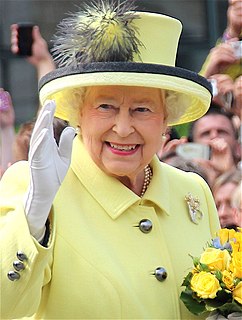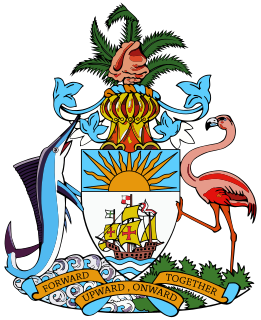A head of state is the public persona who officially embodies a state in its unity and legitimacy. Depending on the country's form of government and separation of powers, the head of state may be a ceremonial figurehead or concurrently the head of government and more.
A monarch is a head of state for life or until abdication, and therefore the head of state of a monarchy. A monarch may exercise the highest authority and power in the state, or others may wield that power on behalf of the monarch. Usually a monarch either personally inherits the lawful right to exercise the state's sovereign rights or is selected by an established process from a family or cohort eligible to provide the nation's monarch. Alternatively, an individual may proclaim themself monarch, which may be backed and legitimated through acclamation, right of conquest or a combination of means.

A monarchy is a form of government in which a person, the monarch, is head of state for life or until abdication. The political legitimacy and authority of the monarch may vary from restricted and largely symbolic, to fully autocratic, and can expand across the domains of the executive, legislative, and judicial. Monarchs can carry various titles such as emperor, empress, king, queen, raja, khan, tsar, sultan, shah, or pharaoh.

The Republics of the Union of Soviet Socialist Republics or the Union Republics were ethnically based administrative units of the Union of Soviet Socialist Republics (USSR). The Soviet Union was created by the treaty between the soviet socialist republics of Belarus, Ukraine, Russia, and the Transcaucasian Federation, by which they became its constituent republics. For most of its history, the USSR was a highly centralized state despite its nominal structure as a federation of republics; the decentralization reforms during the era of Perestroika ("Restructuring") and Glasnost ("Openness") conducted by Mikhail Gorbachev are cited as one of the factors which led to the dissolution of the USSR in 1991.
The head of government is either the highest or second-highest official in the executive branch of a sovereign state, a federated state, or a self-governing colony, autonomous region, or other government who often presides over a cabinet, a group of ministers or secretaries who lead executive departments. "Head of government" is often differentiated from "head of state", as they may be separate positions, individuals, or roles depending on the country.

A federated state is a territorial and constitutional community forming part of a federation. Such states differ from fully sovereign states, in that they do not have full sovereign powers, as the sovereign powers have been divided between the federated states and the central or federal government. Importantly, federated states do not have standing as entities of international law. Instead, the federal union as a single entity is the sovereign state for purposes of international law. Depending on the constitutional structure of a particular federation, a federated state can hold various degrees of legislative, judicial, and administrative jurisdiction over a defined geographic territory and is a form of regional government.

Head of the Commonwealth is a title used by the ceremonial leader who symbolises "the free association of independent member nations" of the Commonwealth of Nations, an intergovernmental organisation that currently comprises fifty-four sovereign states. There is no set term of office or term limit and the role itself involves no part in the day-to-day governance of any of the member states within the Commonwealth. The title has been held by the reigning British monarch since its establishment.
A state government is the government of a country subdivision in a federal form of government, which shares political power with the federal or national government. A state government may have some level of political autonomy, or be subject to the direct control of the federal government. This relationship may be defined by a constitution.
A constituent state is a state entity that constitutes a part of a sovereign state. A constituent state holds regional jurisdiction over a defined administrative territory, within a sovereign state. Government of a constituent state is a form of regional government. Throughout history, and also in modern political practice, most constituent states are part of complex states, like federations or confederations. Constituent states can have republican or monarchical forms of government. Those of republican form are usually called states or autonomous states, republics or autonomous republics, or cantons. Those that have a monarchical form of government are often defined by traditional hierarchical rank of their ruler.

The republics in the Commonwealth of Nations are the sovereign states in the organisation with a republican form of government. As of November 2021, 34 out of the 54 member states were republics. Elizabeth II, who is the reigning monarch in the Commonwealth realms, is also still the titular Head of the Commonwealth in a personal capacity. This role does not carry with it any power; instead, it is a symbol of the free association of Commonwealth members.

The monarchy of the Bahamas is a system of government in which a hereditary monarch is the sovereign of the Commonwealth of The Bahamas. The current monarch and head of state is Queen Elizabeth II, who has reigned since the country became independent on 10 July 1973. The Bahamas share the Sovereign with the other Commonwealth realms. The Queen does not personally reside in the islands, and most of her constitutional roles are therefore delegated to her representative in the country, the Governor-General of the Bahamas. Royal succession is governed by the English Act of Settlement of 1701, as amended by the Succession to the Crown Act 2013 of the Parliament of the United Kingdom, with the latter statute reflecting the Perth Agreement, to which the Bahamas government acceded. The two acts are part of constitutional law.
This page is based on this
Wikipedia article Text is available under the
CC BY-SA 4.0 license; additional terms may apply.
Images, videos and audio are available under their respective licenses.





























